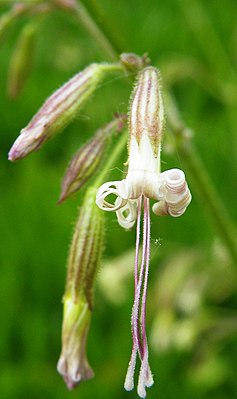Tatar catchfly
| Tatar catchfly | ||||||||||||
|---|---|---|---|---|---|---|---|---|---|---|---|---|

Blossom of the Tatar catchwort ( Silene tatarica ) |
||||||||||||
| Systematics | ||||||||||||
|
||||||||||||
| Scientific name | ||||||||||||
| Silene tatarica | ||||||||||||
| ( L. ) Pers. |
The Tartar campion ( Silene tatarica ) is a plant from the genus of Silene ( Silene ) in the family of Caryophyllaceae (Caryophyllaceae).
description
Vegetative characteristics
The Tatar catchwort grows as a deciduous, perennial , herbaceous plant that reaches heights of 30 to 60 centimeters. The prostrate to ascending stem is lignified at the bottom and almost or sometimes completely bare. It is richly leafed. The opposite constantly arranged leaves are lanceolate configured. The leaf margin has fine teeth, which can usually only be seen with a magnifying glass. Side shoots often develop from the leaf axils.
Generative characteristics
The flowering period extends from July to September. The numerous flowers are clustered together in an upright thyrse . The flower stalk is oriented perpendicular to the flower. It is shorter than the crown and measures about ¼ to ½ the length of the later developing capsule fruit . A noticeable feature are the nodding flowers in contrast to the vertical flower stalk during opening.
The hermaphroditic flowers are radial symmetry and five-fold with a double flower envelope . The five fused tubular sepals form a 9 to 13 millimeter long calyx with raised longitudinal ribs. It has ten nerves, one of which each opens into a calyx tooth and analogously into a calyx bay. The five white or greenish-white petals are 13 to 16 millimeters long, with a deep two-column plate . A secondary crown is not formed. The ovary is on top. There are three free pens available. The stamens and the stigmas rise above the corolla tube.
The capsule fruit opens with six capsule teeth.
The number of chromosomes is 2n = 24.
ecology
The Tatar catchfly is one of the hemicryptophytes in terms of its life form . This means that the survival organs are located on the stem axis at the level of the earth's surface. The innovation takes place via basal axillary buds. A thickened main root, a beet, serves as a storage organ . The epicotyl and hypocotyl are also thickened here and also fulfill the function of storing nutrients.
Tartar catchweed is usually pollinated by insects . Here the nectar is hidden. Typical pollinators are bees , bumblebees and wasps . If there is no cross- pollination , self- pollination is also possible.
The spread of the diaspores takes place via shock propagation, which means that the seeds of the opened capsule fruit are released by gusts of wind or by animals passing by. The Tatar catchfly has a Pleiokorm root system, which enables sprouting, but does not lead to the formation of independent individuals.
Occurrence and endangerment
Tartar catchweed has been found in Europe in Estonia , Latvia , Lithuania , Sweden , Finland , Norway , Poland , Germany and the Ukraine . In Central Europe it occurs seldom and almost exclusively in the eastern area; the sites are limited to areas on the Oder , Vistula and Memel . In Berlin it has the status of a neophyte . The local botanical garden supports the existence of the species through conservation culture . Inconsistent occurrences are recorded in Baden-Württemberg and Mecklenburg-Western Pomerania.
In the 1996 Red List of Endangered Plant Species in Germany, the Tatar catchwort is classified in Category 3, i.e. endangered. In Brandenburg it is also considered endangered.
The Tatar catchfly colonizes richer sand, dry grasslands near the groundwater , for example river terraces . It thrives in Central Europe in the Sileno tataricae-Corynephoretum from the order Corynephoretalia.
swell
literature
- Otto Schmeil , Jost Fitschen (greeting), Siegmund Seybold: The flora of Germany and the neighboring countries. A book for identifying all wild and frequently cultivated vascular plants. 95th completely revised u. exp. Edition. Quelle & Meyer, Wiebelsheim 2011, ISBN 978-3-494-01498-2 .
- Eckehart J. Jäger (ed.): Excursion flora from Germany. Vascular plants: baseline. Founded by Werner Rothmaler . 20th, revised and expanded edition. Spektrum Akademischer Verlag, Heidelberg 2011, ISBN 978-3-8274-1606-3 .
- Henning Haeupler , Thomas Muer: picture atlas of the fern and flowering plants of Germany (= the fern and flowering plants of Germany. Volume 2). 2nd, corrected and enlarged edition. Published by the Federal Agency for Nature Conservation. Ulmer, Stuttgart 2007, ISBN 978-3-8001-4990-2 .
Individual evidence
- ↑ a b c d e f Tatar catchfly. In: FloraWeb.de.
- ↑ a b c Eckehart J. Jäger (Ed.): Exkursionsflora von Deutschland. Vascular plants: baseline. Founded by Werner Rothmaler . 20th, revised and expanded edition. Spektrum Akademischer Verlag, Heidelberg 2011, ISBN 978-3-8274-1606-3 , pages 569 ff.
- ↑ a b Erich Oberdorfer : Plant-sociological excursion flora for Germany and neighboring areas . 8th edition. Verlag Eugen Ulmer, Stuttgart 2001, ISBN 3-8001-3131-5 . Page 362.
- ↑ a b c d Federal Agency for Nature Conservation: Database of biological-ecological characteristics of the flora of Germany
- ↑ Flowers in Swabia: The Tatar catchfly
- ↑ a b data sheet with photo by Michael Hassler and Bernd Schmitt.
Web links
- Tatar catchfly. In: FloraWeb.de.
- Distribution map for Germany. In: Floraweb .
- Datasheet from BlumenInSchwaben .
- Images: Collection of photos of Silene tatarica at sileneae.info , section of an inflorescence at asianflora.com , section of an inflorescence , [1]